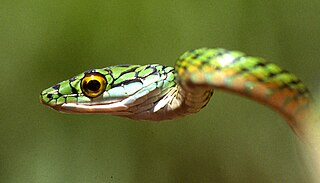
Leptophis ahaetulla, commonly known as the lora or parrot snake, is a species of medium-sized slender snake of the family Colubridae. The species is native to Central America and northern South America.

Ahaetulla nasuta, also known as Sri Lankan green vine snake and long-nosed whip snake, is a venomous, slender green tree snake endemic to Sri Lanka.

Ahaetulla prasina is an arboreal, moderately venomous species of opisthoglyphous vine snake in the family Colubridae, found in Southern and Southeast Asia. Its common names include the Asian vine snake, Boie's whip snake, Gunther's whip snake, and the Oriental whip snake.

Brown-speckled whipsnake or brown vine snake is a species of colubrid vine snake endemic to Sri Lanka.

Boiga cyanea, commonly known as the Green cat snake, is a colubrid snake species found in South Asia, China and South-east Asia.
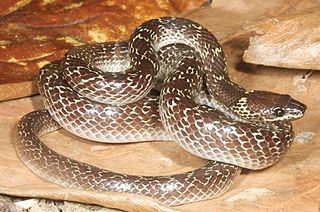
Lycodon capucinus, also known as the common wolf snake, is a species of colubrid snake, which is commonly found in the Indo-Australian Archipelago. Named after their enlarged front teeth, which gives them a muzzled appearance similar to canines, it also makes the snout somewhat more squarish than other snakes.

Gonyosoma oxycephalum, known commonly as the arboreal ratsnake, the red-tailed green rat snake, and the red-tailed racer, is a species of snake in the family Colubridae. The species is endemic to Southeast Asia.

Atheris squamigera is a venomous viper species endemic to west and central Africa. No subspecies are currently recognized.

Ahaetulla, commonly referred to as Asian vine snakes or Asian whip snakes, is a genus of colubrid snakes distributed throughout tropical Asia. They are considered by some scientists to be mildly venomous and are what is commonly termed as 'rear-fanged' or more appropriately, opisthoglyphous, meaning their enlarged teeth or fangs, intended to aid in venom delivery, are located in the back of the upper jaw, instead of in the front as they are in vipers or cobras. As colubrids, Ahaetulla do not possess a true venom gland or a sophisticated venom delivery system. The Duvernoy's gland of this genus, homologous to the venom gland of true venomous snakes, produces a secretion which, though not well studied, is considered not to be medically significant to humans.
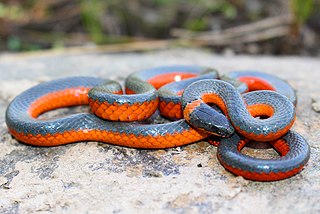
Diadophis punctatus, commonly known as the ring-necked snake or ringneck snake, is a rather small, harmless species of colubrid snake found throughout much of the United States, as well as south in Central Mexico and as far north as Quebec, Canada. Ring-necked snakes are generally fossorial and somewhat secretive, by nature, and, as a nocturnal species, are rarely seen during the daytime. These snakes are believed to be fairly abundant throughout most of their range, though no scientific evaluation supports this hypothesis. Scientific research is lacking for the species, despite their apparently common status, and more in-depth investigations are greatly needed. It is the only species within the genus Diadophis and, currently, 14 subspecies are identified, though many herpetologists question the morphologically-based classifications.
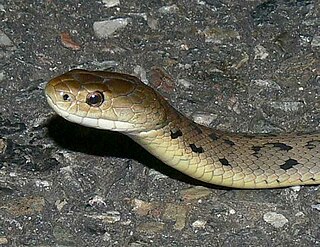
The rough-scaled snake is a highly venomous Australian elapid. The animal's name comes from its scales that are raised above the surrounding scales and have rough texture. The scales are known as "keels".

Boiga philippina, also known as the tawny cat eyed snake or Philippine cat snake, a species of rear-fanged colubrid snake that is endemic to the Philippines.

Ahaetulla mycterizans, the Malayan green whipsnake or Malayan vine snake, is a slender arboreal colubrid vine snake found in Southeast Asia.

Dryophiops is a genus of whip snakes of the family Colubridae, containing two species. They are arboreal tree snakes, found in forests in Southeast Asia.
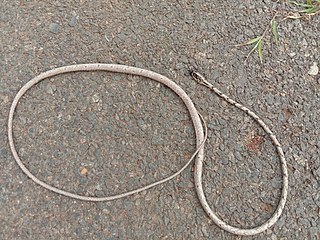
The variable colored vine snake is a species of opisthoglyphous colubrid vine snake found in Bangladesh and India. It is the first reported sexually dichromatic snake from the Indian Subcontinent, and until 2017 was formerly regarded as a subspecies of the green vine snake, Ahaetulla nasuta.

The Ahaetuliinae are a subfamily of vine snakes within the family Colubridae that was erected in 2016. They are found from South and Southeast Asia through to Australia.
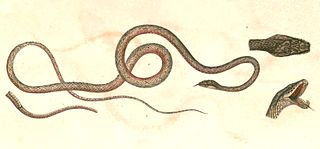
Dryophiops rubescens, commonly known as the red whip snake, is a species of snake in the colubrid family from Southeast Asia.

Proahaetulla is a monotypic genus of vine snake in the family Colubridae. It contains only one species, the keeled vine snake, which is endemic to the Western Ghats of India. Its natural habitat is montane rainforests of southern Western Ghats.

The Indian vine snake or long-nosed vine snake is a species of diurnal, mildly venomous, arboreal snake distributed in the lowlands of peninsular India.Often mistakenly believed to peck out peoples' eyes, this misconception has led to widespread wanton killing of this species.





















